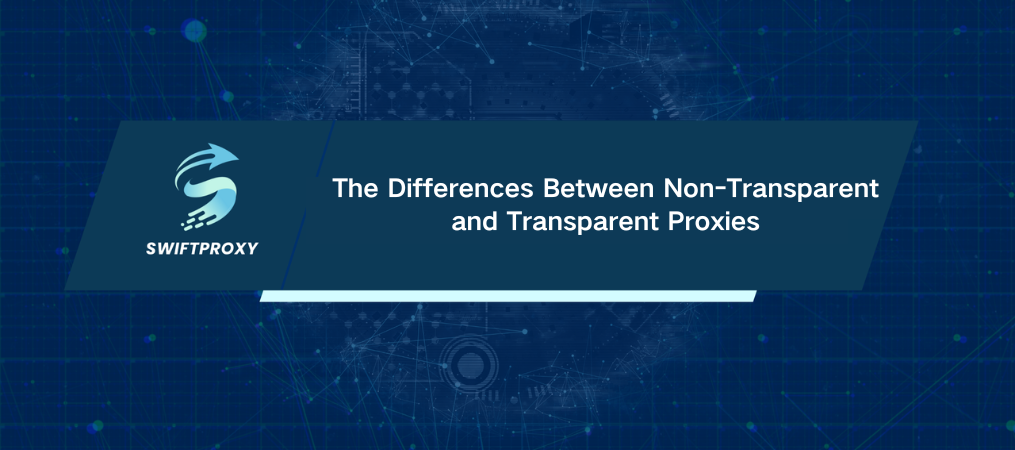The Differences Between Non-Transparent and Transparent Proxies

A proxy server functions as an intermediary between your device and the internet. It handles requests from devices on a network, forwards them to their destinations while using its own IP address instead of the original one, and then sends the responses back to the requesting device.
Most people are unaware that they use transparent proxies daily, particularly when connecting to the internet via public Wi-Fi networks. These proxies go unnoticed because they don't require any configuration. Their main function is to decide whether to forward our requests to their destinations. Transparent proxies handle our requests without altering the IP address, which is why they are called transparent.
Overview of Transparent Proxies
The key aspect of transparent proxies—sometimes referred to as intercepting, inline, or forced proxies—is that they reveal their identity to the destination server you're trying to access. They notify the server that they are acting as a proxy, while your IP address remains unchanged.
Businesses, internet service providers (ISPs), educational institutions, hotels, bars, and other venues with internet access often use transparent proxies for the entire network to avoid the time-consuming task of configuring each device individually. Here are some of the most common applications of transparent proxies:
· Verifying User Identity
A transparent proxy can modify or block traffic according to specific rules. When you connect to a public Wi-Fi or cellular network, the provider typically requires you to accept their terms of service or log in. Once you've completed this process, you can access the internet, and the provider can monitor your network activity, bandwidth usage, and other data.
· Tracking User Activity
In addition to filtering traffic, these proxies can also track user activity. They can log the websites you visit, the duration of your visits, and even monitor attempts to access restricted sites.
· Content Blocking
A transparent proxy provides an effective method for restricting access to certain websites, protocols, and ports. It allows you to restrict chat applications, streaming services, torrent traffic, and more. Businesses often use transparent proxies to keep employees from spending time on social media and other non-productive sites. Likewise, libraries, schools, universities, and other public organizations employ these proxies to enforce similar restrictions.
Overview of Non-Transparent Proxy
In contrast to transparent proxies, semi-transparent and non-transparent proxies—also known as anonymous and high anonymity proxies, respectively—do not disclose the client's IP address to other servers.
It's crucial to note that a semi-transparent proxy server will indicate that a proxy is in use, whereas a high anonymity proxy does not reveal this information. In other words, high anonymity proxies are indistinguishable from regular traffic. Here are some common uses for non-transparent proxies:
· Bypassing geo-restrictions
Many websites, apps, and online resources are restricted to users in certain regions. Additionally, ISPs and governments are imposing stricter internet access controls. To overcome these restrictions and access content, individuals and businesses can use a proxy server located in a region where the resource is available.
· Data Extraction
For modern businesses, reliable and accurate data scraping is very essential. A consistent supply of fresh IP addresses allows you to collect data from any website without encountering IP-based restrictions.
· Managing Social Media Accounts
Companies frequently operate multiple social media accounts to promote their brand and grow their audience. Because most platforms restrict the use of more than one account per IP address, residential proxies are useful for effective management of these accounts, preventing issues with blocks or bans.
The Differences Between Non-Transparent and Transparent Proxies
The main factor to consider in the non-transparent versus transparent proxy debate is the level of privacy they offer. A transparent proxy requires a one-time configuration and then automatically manages network traffic on specified ports, making it versatile across all environments, platforms, apps, and browsers. In contrast, non-transparent proxies must be configured separately for each device, application, or protocol, depending on the particular use case.
As we noted earlier, a transparent proxy server doesn't mask your IP address, location, or other identifiable information. For privacy and anonymity, you should opt for anonymous proxies (or semi-transparent proxies) and high anonymity proxies.
The difference between these two proxy types is straightforward. Anonymous proxies inform destination servers that they are proxies, while high anonymity proxies do not reveal this information. As a result, high anonymity proxies are perceived by online servers as regular user traffic.
Conclusion
This distinction makes non-transparent proxies well-suited for tasks such as web scraping, software testing, market research, social media management, and other situations that require a different IP address from a new location. If you need to browse the internet while protecting your IP, location, and personal information, Swiftproxy offers a variety of solutions designed for speed, reliability, and privacy!

















































